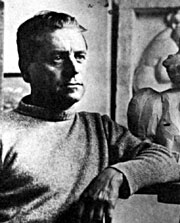
He was born in Buenos Aires, in 1891. He began learning at the atelier of sculptors Torcuato and Arturo Dresco while he also studied at the Academia Nacional de Bellas Artes.
In 1909 the National Congress awarded him a scholarship and he went to Europe. He frequented the Albertina Royal Accademy in Turin, Italy. Two years later, he moved to Paris where he attended the Grande Chaumière. His first works, performed in Paris, are related with Bourdelle’s and Maillol’s sculptural tradition. He was repatriated in 1915 due to the outburst of World War I.
From early 20s to late 30s he worked on a series of relieves. In 1926 he performed Crepúsculo (Twilight)and Salida del Sol (Sunrise), the first “abstract” sculptures ever made in Argentina. These works, though, denote they are inspired in nature.
In the early 30s, together with his friends and colleagues Lino E. Spilimbergo and Luis Falcini, he signed the foundation act of the Plastic Artists Labor Union, though the project would not prosper.
About 1938 he began a series of works concerning the Spanish Civil War among which La viuda (The Widow) and Dolor de España (Grief of Spain) are remarkable. The making of heads and busts characterized the last stage of his sculptural production. Modeled through a faceted structure which produces a game of light and shadows that are cut in the edges, La mujer con sombrero de plumas (The Woman in a Feather Hat), should be mentioned among the works of this period, performed between 1946 and 1953.
He died in Buenos Aires in 1960.